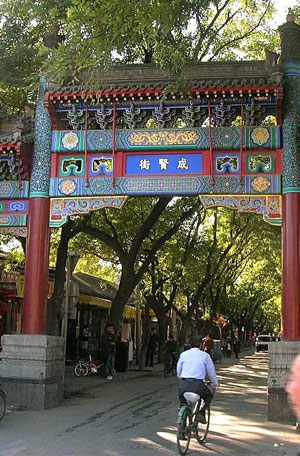A flurry of events and exhibitions around Beijing marks China's third Cultural Heritage Day on Saturday June 14.
Admission is free on this second Saturday in June to many of the capital's museums, memorial halls and temples. Publicity week also features lectures in museums, on campuses and in local communities.

Guozijian Street, the only street left in the city with authentic pailou (decorative ancient Chinese-style gateway) where nestles the Confucius Temple and Imperial College for more than 700 years, is the main Cultural Heritage Day venue. (File Photo)
"The municipal government sets great store by commemorative activities, because they are an important aspect of the 2008 Beijing Olympic cultural events," Cui Guomin, deputy director of the Beijing Municipal Administration of Cultural Heritage explains. "The purpose of the activity is to review Beijing's cultural heritage protection achievements and showcase ancient capital scenarios under the People's Olympics Show Beijing Charm theme."
Guozijian Street, the only street left in the city with authentic pailou (decorative ancient Chinese-style gateway) where nestles the Confucius Temple and Imperial College for more than 700 years, is the main Cultural Heritage Day venue.
After three years of renovations these two edifices, formerly site of the Capital Library and the Capital Museum, the two ancient institutes have merged as the Confucius Temple and Imperial College Museum and are now open to the public.
"Refurbishments at an investment of 20 million yuan (2.89 million U.S. dollars) started in 2005," Cui says. "The municipal government has effectively restored the historical layout and structure of the 700-year-old building complex and retained its original ambience."
There are plenty of other fascinating spots with open day activities to carry on from Guozijian Street.
The Fayuan Temple, located in Jiaozi Hutong of Xuanwu district, was first built in AD 645 during the Tang Dynasty (AD 618-907). It now houses the China Buddhist Institute. The Temple of Ancient Monarchs in Fuchengmennei of Xicheng district, where past emperors were worshiped, was built during the Ming Dynasty (1368-1644). Other places to visit on this one-day trip around the city include the Tianning Temple Pagoda (Liao Dynasty, AD 907-1125) of Xuanwu district; and the Taoist Temple of Huode God (Ming Dynasty, 1368-1644) in Xicheng district.
The Summer Palace is, of course, a main historical spot in the same league as the Great Wall, to which thousands of domestic and international visitors go every year; it is also participant in the Open Day ceremonies. A cultural heritage and horticulture exhibition is being held along the Langru Pavilion and eastern embankment of Kunming Lake that features on-the-spot expert consultations.
Organizers of commemorative exhibition and other activities have taken other measures to ensure maximum enjoyment of Cultural Heritage Day.
The municipal government has produced 324 bilingual explanatory boards giving a brief historical background to municipal-level cultural sites.
Palm-maps will be available at the opening ceremony in Guozijian Street on Saturday June 14. The Kaka 2008 Cultural Relics Tour maps fold to palm-size and comprise six clearly laid out tours: the Museum Tour; Great Wall Hiking Tour; Imperial Life Tour; Mausoleums and Tombs Tour; Pilgrimage Tour; and Ancient Architecture Tour. Loveable cartoon donkey Kaka acts as the visitors' bilingual guide to their Beijing destinations. A full 6 million of these maps will be distributed among Beijing airports, star-rated hotels, embassies and various bars, as well as at Olympic gymnasiums and stadiums.
There will be an estimated 500,000 overseas person/times during the Olympic Games period, according to Yu Ping, deputy director of the administration in charge of issuing these mini-maps. "We must do our best to make these visitors' China tour as enjoyable and trouble-free as possible," Yu says, firmly.
World attention focuses on Beijing in the year 2008. There are more than 3,550 cultural sites in this grand city, which has been a city for 3,000 years and China's capital for 800 years.
"The municipal government invested 330 million yuan in 2000 and 600 million yuan in 2003 in cultural relics protection projects, and have so far restored 139 cultural sites," says Cui. "The medium-to-long term protection project plan from 2008 to 2015 entails an annual investment of 150 million yuan."
(China Daily June 14,2008)